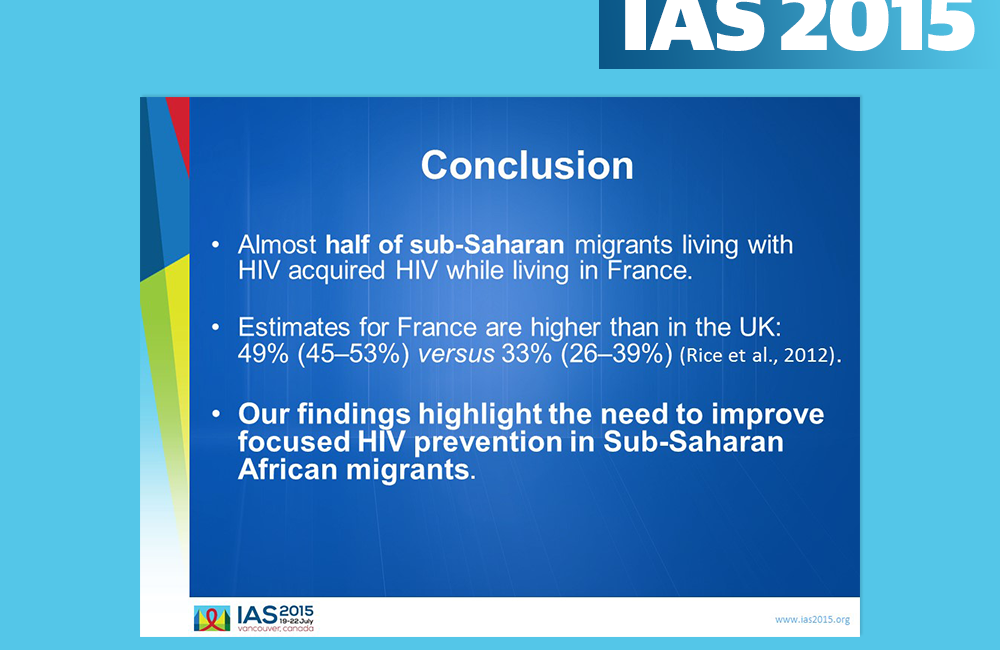
Between a third and a half of African people living with HIV in France probably acquired HIV after they left Africa, according to a study presented to the Eighth International AIDS Society Conference on HIV Pathogenesis, Treatment and Prevention (IAS 2015) on Wednesday.
Until recently, it had generally been assumed that African people who were diagnosed with HIV while living in European countries had acquired HIV before migration. Most come from countries where the prevalence of HIV is very high.
But epidemiologists in the UK found that they could compare the date at which a migrant arrived in the UK with the person’s CD4 cell count at the time of diagnosis (an indication of how long they likely had the infection), in order to estimate where the person was living when they acquired HIV. They calculate that around a third of African people diagnosed with HIV in the UK seroconverted after migration.
If transmission mostly occurs before migration to Europe, the priority for European health services is testing and diagnosis. However, if transmission occurs while living in Europe, a broader prevention response is appropriate.
In France, migrants from sub-Saharan Africa are disproportionately affected by HIV, making up a quarter of all people living with HIV in the country.
For the new analysis, researchers recruited 1031 African migrants who were attending HIV clinics in the country. Life-history data were collected in interviews and medical records were consulted.
For this analysis, 133 people who had been diagnosed before arriving in France were excluded.
Of the remaining 898 people, the life history data showed that 63 people had had an HIV-negative test result while living in France and 28 only began having sex while in the country. Further, 137 people had been diagnosed more than eleven years after arriving in the country. All of these were assumed to have acquired HIV while living in France.
CD4 cell counts were examined for the remaining 537 people, with two different sets of assumptions about how the data should be interpreted.
Based on a conservative assumption, 35% of all migrants diagnosed in France acquired their infection while living in the country. Based on less restrictive assumptions, 49% acquired HIV in France.
Men, younger people and those who had lived in France for longer were more likely to have acquired their infection after migration. For reasons that are unclear, Malians were much more likely to acquire HIV in France than people coming from Cameroon or Ivory Coast.
The conference also heard evidence from Seattle (King County) of African people acquiring HIV while living in the United States. Phylogenetic analysis of 112 samples from African migrants found that 34 samples could be linked with samples of other people living in the Seattle area, suggesting that transmission occurred locally. Some of these transmission clusters only included individuals of African descent living in the local area.
Desgrees du Lou A et al. HIV acquisition after arrival in France among sub-Saharan African migrants living with HIV in Paris area. Estimations from the ANRS PARCOURS study. 8th International AIDS Society Conference on HIV Pathogenesis, Treatment, and Prevention. Vancouver, July 19-22, 2015. Abstract WEPDC0103.
You can download the slides of this presentation from the conference website.
Kerani RP et al. Evidence of local HIV transmission in the African community of King County, Washington. 8th International AIDS Society Conference on HIV Pathogenesis, Treatment, and Prevention. Vancouver, July 19-22, 2015. Abstract WEPDC0104.
You can download the slides of this presentation from the conference website.
Where available, you can view details of sessions, view abstracts, download presentation slides and find webcasts using the conference 'Programme at a Glance' tool.
You can also download a PDF of the abstract book from the conference website.
